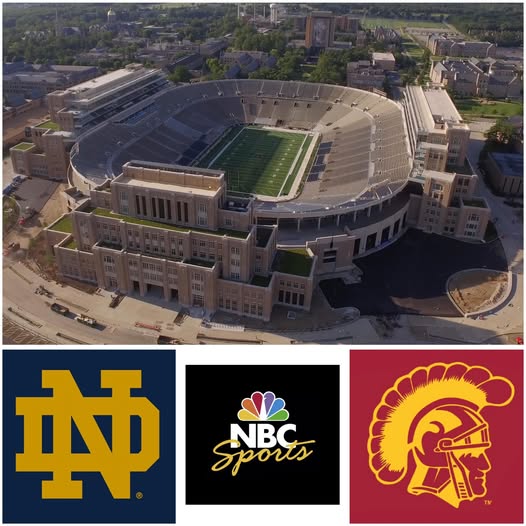SOUTH BEND, Ind. — On October 18, 2025, the echoes in Notre Dame Stadium will sound a little more poignant. When the Fighting Irish host the USC Trojans under the lights for a primetime showdown, it may not just be the latest chapter in college football’s most storied intersectional rivalry — it could be the final one on Midwest soil. And if the whispers coming out of Los Angeles are true, the 97th game in 2026 might close the book on a near-century-old tradition.
A Historic Bond in Jeopardy
Since 1926, Notre Dame and USC have met annually in a rivalry that transcends regional boundaries. Dubbed “The Greatest Intersectional Rivalry” in college football, this clash of titans has delivered Heisman moments, national title implications, and generational bragging rights. It’s the only annual game that regularly pits a traditional Midwest power against a West Coast titan.
But now, USC’s move to the Big Ten Conference in 2024 has thrown the rivalry’s future into jeopardy.
Behind the scenes, there’s growing skepticism that Southern Cal will continue the series beyond the 2026 meeting in Los Angeles. Multiple sources indicate USC’s administration and athletic leadership are leaning toward pulling out of the annual clash due to evolving scheduling demands and the university’s shifting priorities in its new conference ecosystem.
A Scheduling Headache or Excuse?
The heart of the matter lies in scheduling logistics. With USC now a Big Ten member, the Trojans are obligated to play nine conference games each season. Add in traditional matchups against UCLA — now also in the Big Ten — and potentially high-profile early-season contests, and the Trojans’ non-conference flexibility has shrunk dramatically.
In private discussions, USC leadership has reportedly expressed hesitancy about making frequent trips to the Midwest in late October or November, citing player welfare, academic balance, and travel fatigue. While these concerns carry some merit, critics argue that Notre Dame is being unfairly scapegoated.
Notre Dame, after all, continues to operate as an FBS Independent and has crafted an intricate national schedule that includes annual games with the likes of Stanford, Navy, and yes — USC. The Irish have made the trek to the West Coast every other year without complaint for nearly a century. To suggest that USC can no longer do the same feels more like an excuse than a logistical issue.
“USC’s move to the Big Ten was always going to come with trade-offs,” said a senior Notre Dame official who requested anonymity. “But to abandon the longest-standing rivalry outside your conference? That’s not a scheduling conflict — that’s a cultural decision.”
The Implications for Notre Dame
If USC indeed walks away after 2026, Notre Dame would lose not just a historic rivalry, but a foundational element of its national identity. Since Knute Rockne and Howard Jones first scheduled the matchup in the 1920s, Notre Dame–USC has served as a litmus test for both programs. For the Irish, it provides access to California’s fertile recruiting grounds and a high-profile end-of-season showdown that often elevates their national profile.
Without USC, Notre Dame may have to reevaluate its late-season scheduling philosophy. Navy and Stanford still offer some continuity, but they don’t carry the same weight as USC. It would also put pressure on Notre Dame to find another national brand willing to commit to an annual series — a tall order in a world of conference-centric scheduling models.
There’s also a broader emotional toll. The Notre Dame–USC game has become a family affair for generations of alumni, students, and fans. Many families have made it a biannual tradition to travel to South Bend or Los Angeles, anchoring their autumns around the game. If USC departs, that shared ritual vanishes.
Tradition vs. Realignment
In a rapidly shifting college football landscape driven by television revenue and playoff expansion, traditional rivalries are increasingly falling by the wayside. The Bedlam Series between Oklahoma and Oklahoma State is on ice. Texas and Texas A&M went a decade without playing. USC’s potential abandonment of Notre Dame would be just the latest casualty of realignment-era pragmatism.
But it would sting more than most.
This isn’t just a rivalry born out of geography or conference alignment. It was intentionally crafted by visionaries like Rockne and Jones to bridge coasts, cultures, and calendars. It has persisted through wars, societal upheaval, and seismic shifts in the sport. It’s one of the few constants in college football’s chaotic ecosystem.
Ending it wouldn’t just be disappointing — it would be emblematic of what the sport is losing in pursuit of profit and efficiency.
What USC Stands to Lose
From USC’s perspective, the rivalry offers more than a marquee opponent. It’s a branding asset that aligns with their identity as a national program. The Notre Dame–USC game has often served as the linchpin in Heisman campaigns (see: Reggie Bush in 2005, Matt Leinart in 2004), playoff pushes, and even coaching legacies.
It’s also a recruiting magnet. When USC visits South Bend or hosts Notre Dame at the Coliseum, the entire country tunes in. Recruits from Florida to Texas to Washington watch the matchup with intrigue. Walking away from it could signal a retreat into regionality just as USC is trying to expand its national footprint.
And while the Big Ten may offer high-profile matchups, it lacks the narrative weight of Notre Dame–USC. Games against Purdue or Minnesota won’t carry the same emotional stakes, regardless of rankings.
October 18, 2025: A Farewell?
With all this context swirling, October 18 becomes more than just a football game. It becomes a potential farewell to an institution. The energy in South Bend will be electric, not just because it’s a primetime slot against a rival, but because fans will know what’s at stake.
Notre Dame, likely led by quarterback CJ Carr and head coach Marcus Freeman, will be out to defend its turf against a USC team that’s still transitioning under Big Ten expectations and playoff aspirations. The Irish faithful will treat the evening as a celebration of everything this rivalry has meant: the victories, the heartbreaks, the iconic plays.
If this is indeed the final game in South Bend, the atmosphere will be emotionally charged. Expect tributes, retrospectives, and perhaps even Rockne’s ghost walking the sideline one last time.
Looking Ahead to 2026: The (Possible) Final Chapter
Should USC proceed with ending the rivalry, the 2026 matchup in Los Angeles would be the 97th — and final — game between the two schools, dating back to their 1926 debut.
That finale would carry immense historical weight. Would Notre Dame try to spoil USC’s send-off? Would the Trojans rise to the occasion and slam the door with authority? How would fans respond — would they view the game with reverence or resentment?
The very idea of a final USC–Notre Dame game seems unfathomable. But in the era of TV contracts and playoff positioning, sentiment rarely wins out.
What Comes Next?
There’s still hope. College football has proven time and again that it’s capable of surprising us. Contracts can be renegotiated. Tradition can outweigh transition. If enough voices — from fans, media, and former players — speak out, there’s a chance the series could be salvaged.
Notre Dame has expressed a strong desire to keep the rivalry alive. USC, for now, remains officially noncommittal. But insiders believe the decision has effectively already been made behind closed doors.
Should that be the case, it will be up to both schools to honor the series with dignity and reflection. Perhaps a decade from now, cooler heads will prevail, and the series could be revived — as Texas–Texas A&M and Miami–Florida may soon be.
But for now, the writing appears to be on the wall.
Final Thoughts
If October 18, 2025, is indeed the last time USC visits Notre Dame Stadium, the moment will be both celebratory and bittersweet. The greatest intersectional rivalry in college football history may be coming to a quiet, boardroom-orchestrated end.
This isn’t just about scheduling. It’s about legacy. It’s about the power of tradition in a sport increasingly defined by short-term gains. If USC walks away after 2026, it will not only close a chapter — it may burn the book.
Notre Dame and USC have meant too much to each other, and to college football, to let this rivalry fade into memory. Whether the powers that be can see that remains to be seen. But for now, fans should savor every moment of what could be the final acts of an 100-year-old drama — one last golden autumn under the lights in South Bend.



